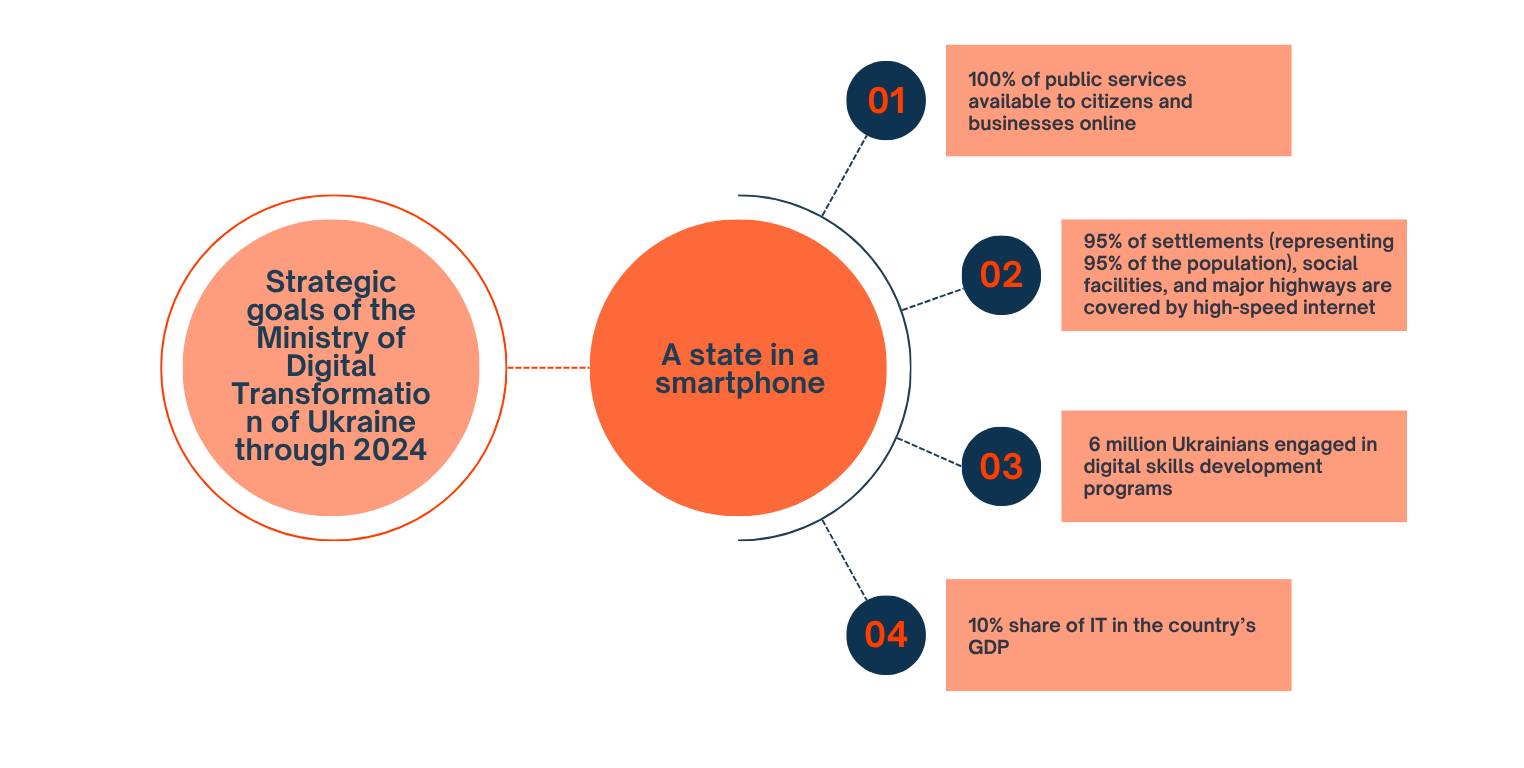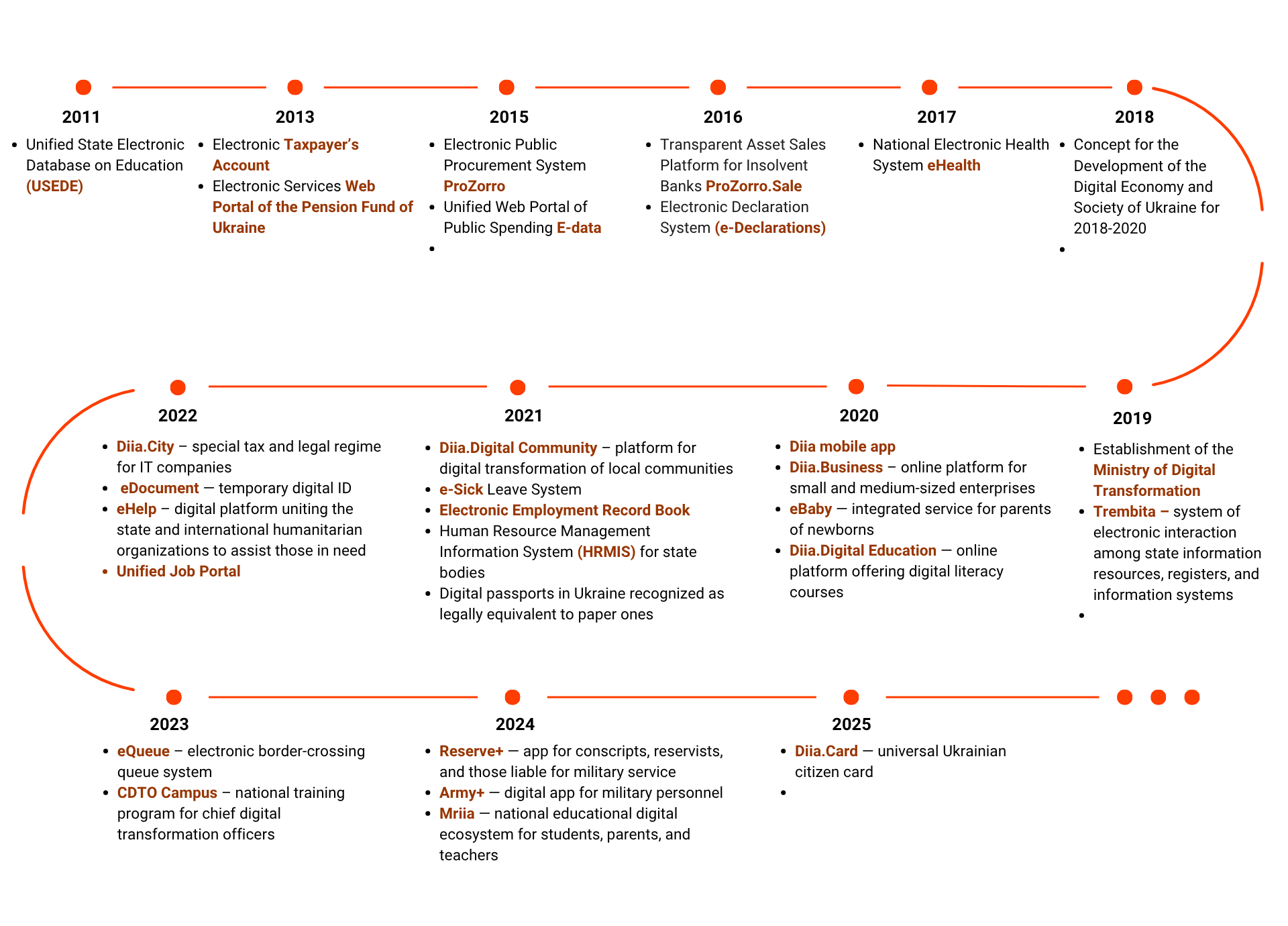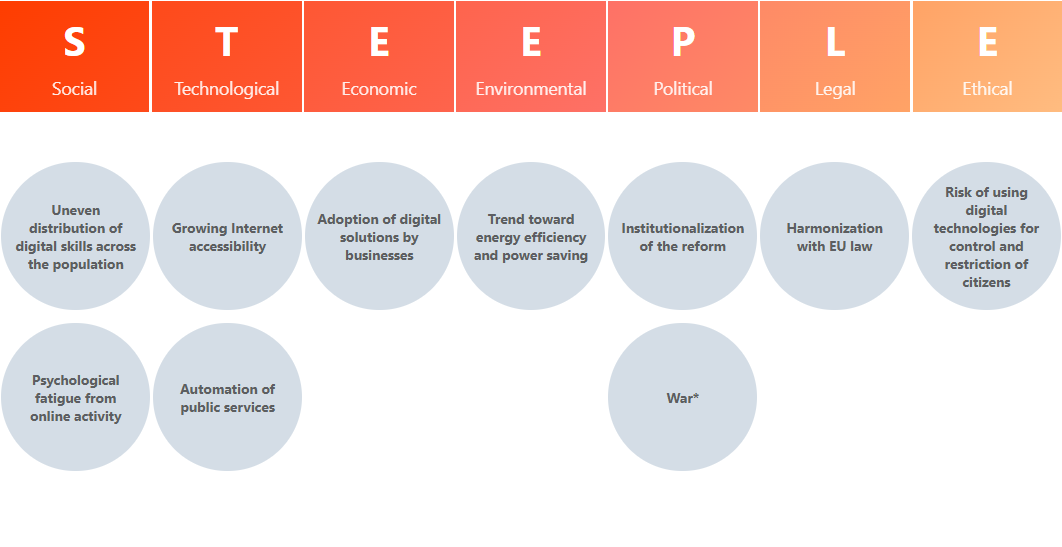For several years in a row, digitalization has remained among the reforms that Ukrainians consider most beneficial to society. It stands alongside defense, anti-corruption reforms, and healthcare. We decided to examine what has been achieved over the past five years of building a “state in a smartphone” and what challenges still lie ahead.
In May 2019, newly elected President Volodymyr Zelensky announced a course toward building the “state in a smartphone“, where most interactions between citizens and the government could be completed in just a few clicks. To realize this idea, Ukraine established the Ministry of Digital Transformation in September of the same year—a dedicated agency focused specifically on digitalization. Electronic initiatives, such as Prozorro and e-declarations, had already proven effective; however, the creation of the ministry enabled the country to accelerate its pace of digital transformation.
Digitalization refers to the process of transferring existing services and functions into a digital format, as well as developing new digital tools to enhance economic efficiency, effectiveness, and the quality of interactions among the state, businesses, and citizens.
Figure 1. History of digital transformation in Ukraine
Already in its first year of operation, the Ministry of Digital Transformation has set strategic benchmarks through 2024, with four goals designed to transform the country and effectively define the framework for its development in the years ahead.
Figure 2. Strategic goals of the Ministry of Digital Transformation of Ukraine through 2024

Goal No. 1: 100% of public services available to citizens and businesses online
A major milestone on the path toward building a “state in a smartphone” was Diia – the mobile app and web portal that, in 2020, gave Ukrainians access to digital documents and basic online services. Through Diia, Ukrainians can register and close a business online, change their place of residence, receive state social benefits, register a marriage, and obtain certificates or services in areas such as construction, education, and social protection. Moreover, Ukraine became the first country in the world to grant full legal validity to a digital passport, meaning that in many situations, an e-passport alone is sufficient, without the need to carry a paper one.
Over five years, Diia has introduced more than 30 digital documents, made over 60 services available in the mobile app, and more than 130 on the web portal. As of 2024, the number of Diia users exceeded 21.7 million, and the total number of requests processed through the ecosystem surpassed 37 million. In 2024, 64% of citizens used government e-services. According to a 2024 survey by the Kyiv International Institute of Sociology, men used government e-services more often than women: 71% compared with 58%. Most did so through the Diia app: 58% of men and 45% of women. In contrast, far fewer citizens accessed services via the portals and websites of individual ministries and agencies, or through the network of administrative service centers. This makes Diia the main platform for interaction between citizens, businesses, and the state.
This enabled Ukraine to make a genuine “digital leap”: while in 2018 the country ranked 102nd in the global index of digital development of public services, by 2024 it had risen to fifth place. Digitalization has also brought economic benefits. According to OECD estimates, the rapid rollout of digital services in 2022 contributed roughly 0.8% to GDP growth by increasing the transparency and efficiency of public administration.
At the same time, digital solutions have become a tool of resilience: online documents for those who lost their paper ones made it possible to verify identity and access essential services and assistance; payments to internally displaced persons (IDPs) were processed via Diia; and compensation for destroyed housing was provided through the eRecovery program, which made it easy to submit claims for compensation for destroyed or damaged homes and thereby accelerated the recovery process for many families. As of September 2025, more than 108,000 Ukrainians had received compensation for damaged housing totaling UAH 10.6 billion, and nearly 23,000 Ukrainians had received housing certificates to purchase new homes worth a total of UAH 33 billion.
In addition, through Diia, citizens gained tools for direct participation in strengthening the economy and national defense (most notably by purchasing war bonds). To support national security, the e-Enemy chatbot was created, enabling citizens to share information with the Armed Forces about enemy positions and collaborators.
However, the rapid development of digital services has also created new challenges. The main one is digital inequality in its various dimensions. In 2023-2024, more than 70% of young people used digital services, whereas among older adults (aged 70 and above), only 22% did. Access to online services is also lower among residents of rural areas compared with urban populations, as well as among low-income citizens. In 2024, 57% of the rural population used e-services, compared with 69% in cities. The second challenge is trust. Although 78-79% of users rate their experience with digital services positively, periodic scandals involving data leaks have eroded public confidence in electronic services. While in 2021, only 16% of respondents expressed distrust, by 2024, that share had risen to 26%. Therefore, technological progress must be accompanied by more active communication with citizens, stronger personal data protection, and the development of digital literacy.
Even more ambitious goals lie ahead. By 2026, the government plans to digitize at least 113 additional services, ranging from healthcare to the judiciary. Some are already operational, such as online services for military personnel (granting disability status, processing one-time payments) and vehicle registration. Yet true success will not be defined by the number of services, but by whether all segments of the population (from students to pensioners) are able to use them.
Goal No. 2: 95% of settlements (more precisely, settlements where 95% of the population lives – ed.), social facilities, and major highways covered by high-speed Internet
The concept of the “state in a smartphone” necessitated not only the creation of new digital services but also the development of foundational infrastructure. That is why one of the four main strategic goals of the newly established Ministry of Digital Transformation in 2019 was to ensure that by 2024, 95% of the population, social facilities, and major highways would be covered by high-speed Internet.
At that time, internet access in Ukraine was far from uniform. In 2019, about 71% of Ukrainians regularly used the internet. In cities, the penetration rate exceeded 74%, while in rural areas it was only about 58% (see Figure 3).
Figure 3. Internet penetration trends in Ukraine
In 2019, Ukraine launched its 4G service, providing approximately 76% of the population with access to it. However, social infrastructure (schools, hospitals, and libraries) often remained unconnected. For mobile operators, expanding networks to such facilities was not a priority, as they focused their investments primarily on areas with higher concentrations of users. This situation made large-scale digitalization impossible, so expanding internet coverage became a separate national goal.
To achieve this goal, in 2020-2021 the government implemented the Internet Subvention program to expand access to high-speed internet in rural communities where network construction was economically unattractive for providers. The state allocated funds to lay fiber-optic lines to schools, hospitals, libraries, and administrative service centers, while local communities prepared project documentation and held tenders to select providers. In this way, construction costs were covered by the state budget, and local authorities were responsible for organizing the process on the ground. Thanks to the program, more than one million Ukrainians and 7,500 social facilities in over 3,000 villages gained access to high-speed internet. The project helped narrow the digital divide between urban and rural areas, connecting critical institutions to the network. By the end of 2024, 89% of social facilities had access to high-speed internet.
At the same time, mobile operators were rapidly expanding 4G coverage: by the end of 2024, 97.6% of the population had access to the network. However, broadband internet was available to a much smaller share – 63% of the population. Mobile internet, though, cannot fully replace fixed connections. Its speed and stability depend on network load, so in settlements without fiber-optic internet (about 15% of all settlements as of 2023) connection quality often deteriorates because residents rely exclusively on mobile networks. An important innovation in addressing this issue will be the launch of Direct to Cell technology in 2025, announced by Kyivstar in partnership with Starlink. The technology will enable 4G smartphones to connect directly to satellites, even without the need for ground-based stations. While it will not replace full-fledged mobile internet (initially supporting only basic services such as SMS or small data transfers) it could become a real breakthrough for remote and small settlements or during power outages. Direct to Cell is currently being tested within a 200-kilometer zone in Ukraine. Starting in November 2025, the company plans to provide its subscribers with access to satellite mobile communications, with the service remaining free for at least the first year.
The full-scale invasion caused significant damage to infrastructure; as of April 2023, more than 4,300 base stations and a substantial portion of backbone networks had been destroyed or damaged. Overall, the total losses to the electronic communications sector were estimated at more than USD 2 billion as of the end of 2023. Therefore, the Ministry of Digital Transformation focused on restoring connectivity in liberated areas and strengthening network resilience. International support played a major role. For example, in 2023 the German government provided grant funding to restore Internet coverage in affected regions, under which telecom companies could receive up to EUR 10,000 for equipment and network operations in de-occupied territories.
In 2023, the government, in collaboration with Nokia, launched a project to modernize mobile and fixed networks, aiming to increase their energy independence. Providers, in turn, implemented xPON technologies to ensure vital communication access during power outages. This technology allows networks to operate for up to 72 hours without electricity. As of 2024, more than 4.2 million fixed internet subscribers were using xPON, accounting for 48.5% of all fixed Internet connections. As a result, according to the Digital Quality of Life Index, Ukraine ranks first among countries in the stability of fixed Internet service.
By the end of 2024, the Ministry of Digital Transformation reported that 90% of the population in government-controlled areas of Ukraine had access to high-speed Internet. Although achieving 95% coverage can be considered a goal close to fulfillment, the objective itself remains relevant while evolving in focus – it now concerns not only access but also the quality and resilience of networks. This is reflected in the terms of the Ukraine Facility, which includes a separate section providing for the implementation of an updated plan for the allocation and use of the radio frequency spectrum. In essence, this builds upon the work initiated in 2019, but on a new technological level – creating the foundation for the development of 5G and the further digitalization of the economy. In 2024-2025, pilot projects for launching 5G were initiated, but a full commercial rollout of the network will be possible only after the war ends.
Ukraine has already taken important steps in this direction. In June 2025, the government approved the Strategy for the Development of the Electronic Communications Sector until 2030, the implementation of which is expected to increase the country’s GDP by approximately UAH 56 billion. The strategy envisions restoring damaged mobile and fixed networks, connecting 75% of households and 99% of social facilities to gigabit internet, ensuring high-quality mobile service for 98% of the population, and harmonizing legislation with the EU, including Ukraine’s accession to the EU’s single roaming zone. In 2024, the European Union made a landmark decision to integrate Ukraine into the “roam like at home” regime starting January 1, 2026. This means that Ukrainians will be able to use mobile services in the EU (and European subscribers in Ukraine) at domestic rates.
Goal No. 3: 6 million Ukrainians engaged in digital skills development programs
At the start of the digital transformation, it became clear that the problem lay not only in the lack of internet coverage but also in the population’s low level of digital skills. According to the Ministry of Digital Transformation, in 2019, 53% of Ukrainians possessed digital skills at a basic level or below, and 15% had no digital skills at all. That is why one of the ministry’s four goals was ambitious – to engage at least 6 million Ukrainians in digital literacy development programs by 2024.
In 2021, the government approved the Concept for the Development of Digital Competences. The document defined digital competences as an essential component of education and professional training for citizens and provided for the creation of a national framework of digital competences aligned with the European DigComp 2.1 model.
DigComp 2.1 (Digital Competence Framework for Citizens) is the European Union’s competency framework that defines what it means to be digitally literate in the modern world: how to search for and verify information, communicate safely online, create content, protect personal data, and solve problems using technology. The model describes different levels of digital skills, ranging from beginner to expert, and serves as a reference point for schools, universities, and professional development programs.
The concept became the methodological foundation for achieving the goal of engaging 6 million citizens, while the practical instrument for its implementation was the launch, in 2020, of the national platform Diia.Digital Education. Presented as a series of short educational videos, it teaches people how to use smartphones, work with e-documents, and protect their data online. As of 2023, the Ministry of Digital Transformation had achieved its target, engaging 6 million Ukrainians in digital literacy programs through the online platform and a network of offline digital education hubs. During this time, the share of Ukrainians with digital skills below the basic level decreased to 40.4%, while the remaining 60% had basic or advanced digital skills.
The full-scale war amplified both the demand for digital services and the need for digital skills. Ukrainians used Diia to access documents, apply for assistance, and report damaged property. In response, educational programs were expanded to include new courses on cyber hygiene, media literacy, and digital security.
At the same time, initiatives began to emerge that prepared a new generation of digital leaders. To accelerate change, in 2020 the Cabinet of Ministers introduced CDTO (Chief Digital Transformation Officer) positions – deputy roles for digitalization across various government agencies. To train qualified professionals, CDTO Campus was launched in 2024 – the world’s first technological education project for the public sector. In its first year, the project received more than 2,600 applications from current and prospective civil servants seeking to join. A total of 440 participants completed the program, enhancing their digital and leadership skills.
To address the long-term problem of low digital skills, the Ministry of Digital Transformation and the Ministry of Education and Science have created the Mriia educational ecosystem to cultivate these skills from early childhood. The platform immerses schoolchildren in a digital environment from a young age, allowing them to plan lessons, complete and review homework, access schedules, and receive other useful information through the app. Daily engagement with a digital product makes the use of technology a natural and integral part of the learning process. In 2024, 40 pilot schools completed their first semester using Mriia.
Thus, the goal of engaging 6 million Ukrainians in digital skills development programs has evolved into building a comprehensive ecosystem, ranging from digital literacy for all to the development of highly qualified specialists and digital leaders. This logic is further reinforced by the Ukrainian Global Innovation Strategy (WINWIN) until 2030, which prioritizes the development of human capital, educational technologies (EdTech), and digital innovation.
Goal No. 4: 10% share of IT in the country’s GDP
One of the Ukrainian government’s key priorities has been to create a favorable environment for the development of the IT industry. The response to this challenge was the Diia.City initiative, launched in February 2022 (literally just before the full-scale invasion). In essence, Diia.City is a special tax and legal regime for IT companies, under which tax rates for residents are several times lower than the national average. Residents pay only 5% personal income tax, 5% military levy, and 22% of the minimum wage as a unified social contribution. Instead of the standard 18% corporate income tax, companies may opt for a 9% tax on withdrawn capital, applied only when dividends are paid or funds are distributed.
Companies within Diia.City can work flexibly with specialists: in addition to standard employment contracts, gig contracts are also permitted. This form of cooperation allows professionals to be engaged for specific projects without being added to the company’s staff. Unlike a civil law contract, under which only the result of work is paid for (for example, a finished product or service), a gig contract provides payment for working time and guarantees the specialist social rights, such as paid leave, sick leave, and protection against unlawful dismissal. Compared to the sole proprietor (FOP) model, gig contracts reduce risks for specialists, as they do not need to manage accounting or pay taxes independently, since these responsibilities are handled by the company.
In Diia.City, investors can enter into agreements with Ukrainian IT companies not only under Ukrainian law but also under English law, which is more familiar to international businesses and provides well-established mechanisms of protection. This increases confidence in Ukrainian companies. The regime also allows for options (the right to purchase a share in a business at a fixed price) and convertible loans (where an investment can be converted into an equity stake in the company). Particular emphasis is placed on protecting intellectual property and personal data: residents have legal tools to formalize rights to their products and safeguard them against unauthorized use.
At first, the project was primarily aimed at outsourcing companies, research centers, and technology startups. But the war quickly shifted priorities. Today, within Diia.City, special attention is given to companies working in defense technology (particularly developers of unmanned systems). This approach enables Ukraine to simultaneously support the growth of its civilian IT sector and enhance its defense capabilities.
As of October 2025, Diia.City had 2,836 resident companies. Among them are global corporations such as Ajax, Visa, Samsung, Intellias, and EPAM, as well as leading Ukrainian firms such as SoftServe and GlobalLogic.
In parallel, the government has been developing the eResidency project. It enables foreign professionals in the IT and creative industries to conduct business in Ukraine remotely and automatically pay taxes here. The program was officially launched in September 2024. In the first week after the launch, more than 200 applications for e-resident status were submitted, and nine individuals confirmed their status and opened accounts in Ukrainian banks. During the program’s first year, 116 people obtained e-resident status, with 85 of them registering as sole proprietors and subsequently opening bank accounts in Ukraine. The Ministry of Digital Transformation had planned to attract around 1,000 participants by September 2025, which in financial terms would amount to roughly USD 1 million in annual revenue for the state budget. The program is currently available to citizens of India, Pakistan, Thailand, and Slovenia.
Despite notable successes, Ukraine has not yet achieved its strategic goal of reaching 10% of GDP from IT. According to analysts, the IT sector accounted for approximately 3.4-5% of the country’s GDP in 2024. Digital State UA estimated the IT contribution at 3.4%, compared with nearly 5% in 2022. The industry’s growth is constrained by the war and related risks, including the mobilization of specialists, security threats, and attacks on energy infrastructure, which force companies to invest in backup solutions, increase costs, and reduce productivity. Another barrier lies in the changing global market: outsourcing budgets have shrunk, competition has intensified, and Ukrainian companies must now fight even harder for clients. There are also internal challenges, such as a shortage of human capital: the outflow of professionals abroad and growing burnout among those who remain limit the potential to scale projects.
Given these challenges, training new professionals has become crucial. To this end, in 2022 Ukraine launched the IT Generation program—a project of the Ministry of Digital Transformation implemented in partnership with the Binance blockchain ecosystem and the Lviv IT Cluster. The program’s goal was to give people with no prior experience in IT an opportunity to acquire a new profession. Participants could choose from several tracks: front-end and back-end development, software testing, UI/UX design, and digital marketing. Training lasted several months in partner IT schools, with all costs covered by donor funding, including from USAID. In the first wave, more than 22,000 people applied, about 2,000 were selected to complete the full course, and only 20% of them (368 individuals) succeeded in finding employment in the IT industry.
Even so, despite the challenges, IT remains one of Ukraine’s key “exporters of resilience”. As of early 2025, IT and telecommunications accounted for 43% of all service exports. In 2024, the IT industry generated USD 6.45 billion in export revenue for the Ukrainian economy, equivalent to 3.4% of the country’s GDP.
A detailed analytical review of Ukraine’s digital transformation and all regulatory and legal changes for 2019-2024, conducted by Vox Ukraine and GGTC Kyiv, is available here.
New strategic priorities of digital transformation
The Ministry of Digital Transformation’s first four goals set the pace and laid the foundation for the “state in a smartphone”. The next stage of reform, however, opens up an even more ambitious horizon. By 2028, the ministry has defined five strategic objectives (see Figure 4), now planned using the Objectives and Key Results (OKR) methodology, which involves formulating goals and specific measurable outcomes that demonstrate progress toward achieving them.
Figure 4. New strategic goals of the Ministry of Digital Transformation of Ukraine for 2025-2027
These priorities align with the commitments Ukraine has undertaken under the Ukraine Facility, including providing the population with high-quality connectivity, strengthening cybersecurity, developing innovative companies, and gradually removing barriers between the Ukrainian and European digital spaces.
The only one of the four digital transformation indicators under the Ukraine Facility Plan that has not yet been implemented is support for electronic identification. Ukraine must align its legislation with the EU’s eIDAS Regulation (Electronic Identification, Authentication and Trust Services), which will enable the mutual recognition of Ukrainian e-identities within the EU. For citizens and businesses, this will mean that Ukrainian digital tools can be used on par with European ones without duplication or additional barriers. According to the plan, the government is expected to meet this indicator by the second quarter of 2026.
Factors influencing digital transformation
However, the development of a digital state depends not only on the Ministry of Digital Transformation’s internal strategy or its commitments to international partners. It is shaped by a combination of external and internal factors that together create possible future scenarios. An analysis based on the STEEPLE framework enables the identification of both the opportunities that drive digital transformation and the risks that hinder its development.
Figure 5. Analysis of drivers of digital transformation in Ukraine
Note: The war is a cross-cutting factor that influences several areas; however, in this analysis, it is classified among the political factors.
Among the drivers that positively influence the progress of the reform are the expansion of Internet coverage, the growth of digital skills among the population, and the active participation of businesses in developing new services. Each of these factors directly accelerates the implementation of e-services: more people gain access to Diia, more companies use electronic documents, and artificial intelligence makes public services faster and more convenient.
At the same time, key challenges create areas of risk. Digital inequality refers to the fact that some citizens still lack stable Internet access or the necessary skills to utilize digital services effectively. Low public trust in the government constrains even the most successful projects, as citizens remain concerned about the security of their personal data. Energy instability during the war poses a threat to the continuity of digital services, while growing cyber threats underscore the need for increased investment in protecting critical infrastructure. Finally, the rapid development of artificial intelligence presents both a major opportunity and a challenge: without clear rules for its use, the risks of discrimination, decision-making errors, and the spread of disinformation increase; yet excessive regulation of AI could, in turn, hinder its domestic development.
To assess how these opposing trends might develop, the study applied the foresight method known as future wheels. This approach enables the mapping of potential consequences: from immediate and obvious effects to indirect and longer-term outcomes that shape future scenarios. Figure 5 presents the key future drivers and their likely impacts.
The continued success of this reform depends on how effectively the state can strengthen positive factors and mitigate risks. Achieving this requires consistent, coordinated action across several key areas.
First and foremost, efforts should focus on strengthening the accessibility of digital solutions: expanding Internet coverage nationwide, providing vulnerable groups with necessary equipment, and developing digital literacy training programs for older adults. Equally important is rebuilding public trust through maximum transparency in the operation of digital services and robust protection of sensitive information.
Another key priority is ensuring the continuity of digital services. This requires investment in backup power systems and cloud-based solutions that keep services running even under crisis conditions.
The development of new technologies, particularly artificial intelligence, necessitates clear regulation. Transparent rules must be established for its use in the public sector to prevent politicization, discrimination, or erroneous decisions.
Finally, an equally important task is the active engagement of businesses and citizens in the creation and improvement of digital services. Only a partnership model (one that takes real user needs into account and enables convenient solutions to be developed from day one) can ensure the lasting sustainability of the reform.
Ukraine’s digital transformation is progressing unevenly, shaped by a range of diverse and often opposing factors: some unlock new opportunities, while others create barriers. Therefore, the future success of digital transformation will depend on how effectively the state and society can reinforce the positive drivers and mitigate the risks.
The report is produced by NGO Vox Ukraine with the support of the Askold and Dir Fund as a part of the Strong Civil Society of Ukraine – a Driver towards Reforms and Democracy project, implemented by ISAR Ednannia, funded by Norway and Sweden. The contents of this publication are the sole responsibility of NGO Vox Ukraine and can in no way be taken to reflect the views of the Government of Norway, the Government of Sweden and ISAR Ednannia.

Attention
The authors do not work for, consult to, own shares in or receive funding from any company or organization that would benefit from this article, and have no relevant affiliations







